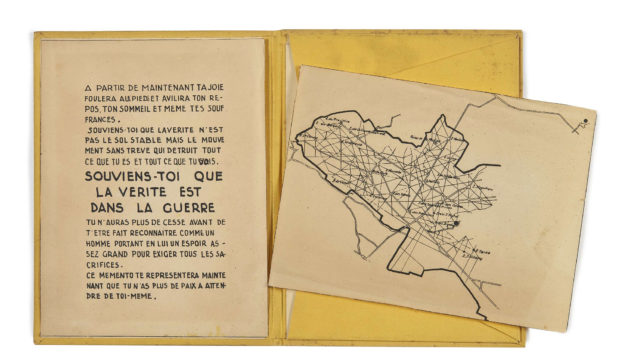An iconographic and text archive related to communication, technology and art.
From now on, your joy will debase and trample underfoot your repose, your sleep, and even your suffering.
Remember that truth is not stable ground but the ceaseless movement that destroys all that you are and all that you see.
REMEMBER THAT IN WAR IS TRUTH
You will not cease before you recognize yourself as a man who carries within him a hope great enough to demand all sacrifices.
This Memento will remind you that from this moment you can no longer expect any peace from yourself.
☛ Georges Bataille’s Memento, March 1937. Reproduced in The Sacred Conspiracy. The internal papers of the Secret Society of Acéphale and lectures to the College of Sociology by Georges Bataille, illustrated by André Masson, edited and introduced by Marina Galletti & Alastair Brotchie, translated by Natasha Lehrer, John Harmann, Meyer Barash, London: Atlas Press, 2017, p. 175.

At the time of writing, a large format, color photo reproduction of the original French version –along with useful explanations– was available at the official website of Artcurial, a French auction market. The website also offer a transcription of the full Memento, along with its map, as it was offered to the members of Acéphale during induction ceremonies. It is worth noting how «tout ce que tu sais» was changed for «tout ce que tu vois»:

À partir de maintenant ta joie foulera au[x] pied[s] et avilira ton repos, ton sommeil et même tes souffrances. Souviens-toi que la vérité n’est pas le sol stable mais le mouvement sans trêve qui détruit tout ce que tu es et tout ce que tu [vo]is. Souviens-toi que la vérité est dans la guerre. Tu n’auras plus de cesse avant de t’être fait reconnaître comme un homme portant en lui un espoir assez grand pour exiger tous les sacrifices. Ce memento te représentera maintenant que tu n’as plus de paix à attendre de toi-même.
The excellent volume of The Sacred Conspiracy also provides useful information about the context in which this memento was produced, distributed and used. In her essay “The Secret Society of Acéphale: A Community of the Heart”, Marina Galleti expands on the function the Memento played for the origins of Acéphale:
Its [the memento] central tenet, that “in war is truth” [la vérité est dans la guerre], allies it with the philosophy of Heraclitus who elevated conflict to a cosmic principle that imposed its rule upon humanity. This text is also a sort of recollection of Bataille and Masson’s unforgettable “conversations of April” in Tossa de Mar in 1936, and thus of the second issue of Acéphale, “whose pages were like symbols of fire” at the Nietzschean festival where this pre-Socratic philosopher presided over the death of God. Included with the “Memento”, in a canvas folder for each member, was a map of the forest of Marly, which revealed the two sacred sites of Acéphale. The first of these was the stricken oak of Acéphale, which was probably the oak of Joyenval, at the edge of the “Étoile Mourante” (the Dying “Star”), as described in more detail in “Marly, Montjoie…” following. The second was the ruins of Montjoie, connected by the Gate of Joyenval to the abbey of the same name. Beyond that was the wall surrounding the ‘Désert de Retz’, an estate presided over by a chateau built in the form of “a truncated column” and with various other unusual buildings, including a pyramid and a small temple, which Bataille and his partner, Colette Peignot (Laure), found conducive to their nocturnal rituals.
One of the main source for this information is Claudine Frank’s “Acéphale/Parsifal. Georges Bataille contra Wagner”, in Durkheim, the Durkheimians, and the Arts, ed. Eugene Jolas, A. Riley, W.S.F. Pickering and W.W. Miller, Durkheim Press/Berghahn Books, New York, 2013, p. 279.
In some additional comments, Marina Galletti provides further explanation about the influences behind the Memento and links it to another short essay by Bataille, “The Heraclitean Meditation”:
Its [the Memento] affirmation that “In War is Truth” allies it with the philosophy of Heraclitus, who was closely associated with Nietzsche in Acéphale 2, and was further evoked in a letter from Masson to Bataille as “the one who endorses all aspects of struggle and questioning whilst laying down an absolute challenge to everything associated with the idea of Being.” Heraclitus reappears in the later issues of the magazine as a cosmic principle that imposes his laws on everything else. In issue 3/4 he presides over the mythical opposition between the Caesarean sky and the Dionysian earth in Bataille’s “Nietzschean Chronicle”, while in issue 5, the “Heraclitean Meditation”, brings to a close the mystical and initiatory exercises of joy in the face of death. Heraclitus reappears again in an aphorism in Bataille’s Anti-Christian’s Manual: “Heraclitism is the sensation of the earth trembling and the fall into empty space as felt in the Nietzschean experience of the death of God”.
The opening of the essay “The Heraclitean Mediation” is well known: “I myself am war,” declares Bataille. The English translation is available in Visions of Excess: Selected Writings, 1927-1939 (U. of Minnesota Press, 1985, p. 239). The Original French version appears in Acéphale no. 5, in 1939, pp. 22-23 (available online).

- By Philippe Theophanidis
- on
- ― Published in Communication, Literature
- Tagged: Acéphale, Bataille, community, Heraclitus, war
